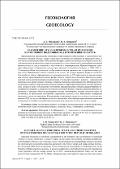| dc.contributor.author | Невзорова, А. Б. | |
| dc.contributor.author | Шершнёв, О. В. | |
| dc.coverage.spatial | Минск | ru_RU |
| dc.date.accessioned | 2024-10-08T08:17:52Z | |
| dc.date.available | 2024-10-08T08:17:52Z | |
| dc.date.issued | 2024 | |
| dc.identifier.citation | Невзорова, А. Б. Накопление отходов производства и их влияние на состояние подземных вод в Республике Беларусь / А. Б. Невзорова, O. В. Шершнёв // Труды БГТУ. Сер. 2, Химические технологии, биотехнологии, геоэкология. – 2024. – № 2. – С. 194–200. | ru_RU |
| dc.identifier.uri | https://elib.gstu.by/handle/220612/38285 | |
| dc.description.abstract | Промышленное производство неизбежно сопровождается образованием и накоплением значительных объемов отходов, которые оказывают негативное воздействие на природную среду, в том числе на подземные воды. В Республике Беларусь одним из основных источников такого воздействия являются накопленные крупнотоннажные отходы химической и деревообрабатывающей промышленности, представленные в виде отвалов и шламохранилищ. Проанализирована динамика образования и накопления отходов производства в Республике Беларусь за 2000–2022 гг. Установлена общая тенденция роста образования отходов производства со среднегодовым темпом 4,8%. Накопленные отходы производства за этот же период времени возросли на 88,7%. Среди общего объема образующихся отходов производства до 99% приходится на крупнотоннажные отходы, представленные галитом, фосфогипсом и гидролизным лигнином. Рассмотрен компонентный состав крупнотоннажных накопленных отходов производства и веществ – загрязнителей подземных вод, среди которых хлориды, сульфаты, фосфаты, аммонийный азот. Обобщены пути и механизмы миграции загрязняющих веществ в пределах территорий размещения отходов производства, которые в целом обусловлены уплотнением свежеотсыпаемых отходов, выщелачиванием атмосферными осадками с поверхности отвалов и ветровой эрозией. Оценена динамика развития загрязнения в пределах объектов размещения отходов производства, которая свидетельствует об устойчивом, на протяжении десятилетий, загрязнении подземных вод. Загрязнению подвержены грунтовые и межпластовые воды. Концентрации загрязняющих веществ в десятки и сотни раз превышают ПДК для вод хозяйственно-питьевого назначения. Масштабы распространения загрязнения в зависимости от объекта воздействия проявляются на площадях от сотен до тысяч гектаров. | ru_RU |
| dc.description.abstract | Industrial production is inevitably accompanied by the formation and accumulation of significant
volumes of waste, which have a negative impact on the natural environment, including groundwater.
In the Republic of Belarus, one of the main sources of such impact is accumulated large-tonnage waste from
the chemical and woodworking industries, presented in the form of dumps and sludge storage facilities.
For the period 2000–2022 the dynamics of the formation and accumulation of industrial waste in the
Republic of Belarus has been analyzed. A general trend has been established for the growth of production
waste generation with an average annual rate of 4.8%. Accumulated production waste over the same
period of time increased by 88.7%. Halite, phosphogypsum, and hydrolytic lignin are the main sources of large-tonnage waste, accounting for up to 99% of the total production waste volume. The component
composition of large-tonnage accumulated industrial waste and groundwater pollutants, including chlo-
rides, sulfates, phosphates, and ammonium nitrogen, has been considered. The pathways and mechanisms
of pollutants migration within industrial waste disposal territories has been generalized. Compaction of
fresh dumped waste, precipitation leaching from the surface of dumps, and wind erosion are the main
causes of them in general. The dynamics of pollution development within industrial waste disposal sites
has been assessed. It indicates persistent groundwater pollution over decades. Contamination can occur
in both groundwater and middle water. Concentrations of pollutants are tens and hundreds of times higher
than the maximum permissible concentration for drinking water. The spreading of pollution, depending
on the object of impact, can happen in areas that range from hundreds to thousands of hectares. | |
| dc.language.iso | ru | ru_RU |
| dc.publisher | БГТУ | ru_RU |
| dc.subject | Отходы производства | ru_RU |
| dc.subject | Солеотвалы | ru_RU |
| dc.subject | Шламохранилища | ru_RU |
| dc.subject | Отвалы фосфогипса | ru_RU |
| dc.subject | Компонентный состав отходов производства | ru_RU |
| dc.subject | Подземные воды | ru_RU |
| dc.subject | Industrial waste | ru_RU |
| dc.subject | Salt dumps | ru_RU |
| dc.subject | Sludge storage facilities | ru_RU |
| dc.subject | Phosphogypsum dumps | ru_RU |
| dc.subject | Industrial waste’s component composition | ru_RU |
| dc.subject | Groundwater | ru_RU |
| dc.subject | Pollution | ru_RU |
| dc.title | Накопление отходов производства и их влияние на состояние подземных вод в Республике Беларусь | ru_RU |
| dc.title.alternative | Accumulation of Industrial Waste and Their Influence on the Condition of Groundwater in the Republic of Belarus | ru_RU |
| dc.type | Article | ru_RU |
| dc.identifier.udc | 556.388:661.632.2 | |
| local.identifier.doi | 10.52065/2520-2669-2024-283-22 | |
